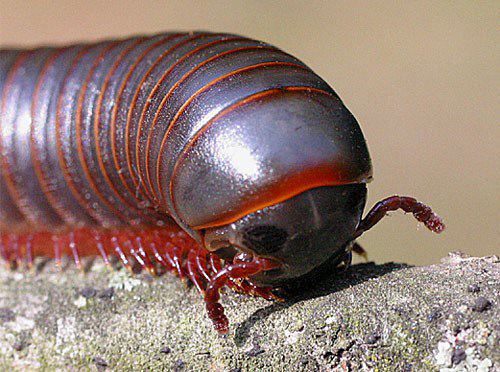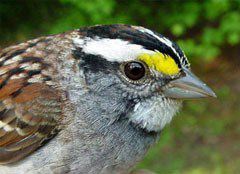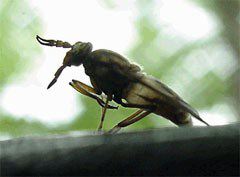|
|
|||
|
|
|||
Back to Preceding Week; on to Next Week
|
NIGHT OF A THOUSAND LEGS As diurnal creatures who snuggle up in bed at night, it's sometimes easy for humans to forget that the world of nature may be just as active after sundown when we can't see what's going on. Creatures such as Southern Flying Squirrels and Bobcats have eyes far more sensitive to light than ours, and they navigate the midnight woods at Hilton Pond Center as easily as we do at noon. Great Horned Owls swoop through night skies, using acute hearing to find their prey, and Red Bats certainly have no trouble echolocating flying insects and gobbling them down on the darkest of nights. Fortunately, despite our poor biological adaptations to nocturnal activity, humans were able to use our brains to invent flashlights, and this simple tool allows any of us to journey forth after dark to see what's out and about. 
All text & photos © Hilton Pond Center Such was the case this week when we were up well before dawn and walking along one of the Center's trails. Our flashlight of preference is a headlamp that frees both hands and allows us to aim the beam exactly where we're looking. As we rounded a bend in the trail, we pointed the light downward and spotted something moving slowly across the path. It looked like a shiny brown tube, but there was little doubt about its identity: it was a "thousand-legger," or millipede.
All text & photos © Hilton Pond Center Despite their name, millipedes don't really have a thousand legs, but they seem to. Most species bear two pairs of legs on all but the first several segments--each of which has only a single pair; the photo below posterior shows quartets of legs on the millipede's posterior segments. Since the specimen we found at Hilton Pond Center had 48 segments (not counting the head and tail) that means, if we calculate correctly, this particular millipede had, hmmm, let's see, 48 minus 5 segments with only one pair each is 43, times 4 is 172 legs, plus 2 legs times 5 segments is 10, equals, hmmm, a total of 182 legs. It's hard enough for us to just count these appendages, so it's a real wonderment that a millipede is able to coordinate them all and move about so effortlessly by night on the forest floor.
All text & photos © Hilton Pond Center Millipedes are in the Diplopoda, the invertebrate class whose name actually translates as "double feet" and refers to those segments with two pairs of legs. "Thousand-legger" millipedes are distantly related to the centipedes (Class Chilopoda), which are "hunnert-leggers" with only a single pair of legs per segment. Centipedes are more likely to be encountered by humans, since they often hang out in basements and in spring have been known to migrate in large numbers up from the cellar, across the living room, down the hall, and out into the night . . . and sometimes back. (In fairness, we should mention that a few house-loving millipede species exhibit this same behavior.) Centipedes--which prey on insects and spiders--have menacing pincer-like mouthparts that in large specimens are capable of inflicting a painful bite and injecting poison. Curiously, these poison jaws are really modified legs; "Chilopoda" loosely translates as "lip foot." Our millipede, a far gentler organism, doesn't nip but defends itself in a quite different manner, as we were reminded when we picked it up on the trail. The majority of the 1,400 known species of North American millipedes dine on decaying vegetable matter and fungi and play a crucial role in decomposition of leaf litter and nutrient cycling. Some species browse on roots, stems, or leaves of live plants and can cause problems in the garden, while a very few millipedes have modified mouthparts that allow them to take live prey such as insects and earthworms. As demonstrated by our encounter this week, most millipedes are creatures of the dark that forage by day beneath dead leaves and occasionally venture forth at night. The specimen we found this week at Hilton Pond Center is Narceus americanus; at four inches long and a half-inch in diameter, it is by far the largest millipede in the Carolina Piedmont. In comparison, the common Garden Millipede, Oxidus gracilis, is less than an inch in length and only an eight of an inch wide. N. americanus, which seems to have no common name, occurs across much of the eastern U.S. and into southern Canada; it is identifiable by a dark purplish-brown body with a thin band of red on the rear edge of each segment. Comments or questions about this week's installment?
Checks can be sent to Hilton Pond Center at: All contributions are tax-deductible on your |
--SEARCH OUR SITE-- For your very own on-line subscription to "This Week at Hilton Pond," |
Thanks to the following fine folks for recent gifts in support of Hilton Pond Center for Piedmont Natural History and/or Operation RubyThroat: The Hummingbird Project. Your tax-deductible contributions allow us, among other things, to continue writing, photographing, and sharing "This Week at Hilton Pond" with students, teachers, and the general public. Please see Support or scroll below if you'd like to make a gift of your own. We're pleased folks are thinking about the work of the Center and making donations. Those listed below made contributions received during the period. Please join them if you can in coming weeks. Gifts can be made via PayPal (funding@hiltonpond.org); credit card via Network for Good (see link below); or personal check (c/o Hilton Pond Center, 1432 DeVinney Road, York SC 29745).
|
If you enjoy "This Week at Hilton Pond," please help support Hilton Pond Center for Piedmont Natural History. It's painless, and YOU can make a difference! (Just CLICK on a logo below or send a check if you like; see Support for address.) |
|
Make credit card donations on-line via Network for Good: |
|
Use your PayPal account to make direct donations: |
|
If you like shopping on-line please become a member of iGive, through which 1,500+ on-line stores from Amazon to Lands' End and even iTunes donate a percentage of your purchase price to support Hilton Pond Center.  Every new member who registers with iGive and makes a purchase through them earns an ADDITIONAL $5 for the Center. You can even do Web searches through iGive and earn a penny per search--sometimes TWO--for the cause! Please enroll by going to the iGive Web site. It's a painless, important way for YOU to support our on-going work in conservation, education, and research. Add the iGive Toolbar to your browser and register Operation RubyThroat as your preferred charity to make it even easier to help Hilton Pond Center when you shop. Every new member who registers with iGive and makes a purchase through them earns an ADDITIONAL $5 for the Center. You can even do Web searches through iGive and earn a penny per search--sometimes TWO--for the cause! Please enroll by going to the iGive Web site. It's a painless, important way for YOU to support our on-going work in conservation, education, and research. Add the iGive Toolbar to your browser and register Operation RubyThroat as your preferred charity to make it even easier to help Hilton Pond Center when you shop. |
|
|
|
|
SPECIES BANDED THIS WEEK * = New species for 2003 WEEKLY BANDING TOTAL 16 species 26 individuals
YEARLY BANDING TOTAL (2003) 44 species 571 individuals
BANDING GRAND TOTAL (since 28 June 1982) 123 species 42,685 individuals
NOTABLE RECAPTURES THIS WEEK (with original banding date, sex, and current age) Ruby-throated Hummingbird (1) American Goldfinch (1) Eastern Wood-Pewee (1) Pine Warbler (1) Northern Cardinal (5) Eastern Towhee (2) Carolina Wren (2) Tufted Titmouse (1) Brown Thrasher (1) |
 Common in winter across the Carolina Piedmont, this species is seldom seen after mid-May. The one banded on 27 May 2003 at Hilton Pond Center is an apparent late record--by ten days-- for the Carolinas, although five summer vagrants have been reported through the years. OTHER SIGHTINGS OF INTEREST --Another 1.2" of rain fell at Hilton Pond Center on 21-22 May, followed by a 3.25" frog-strangler on 22-23 May. Then there were unusual sunny-stormy-sunny-stormy epidoides on 25 May that netted another 1.4" of precipitation. Only seven days in three months has the pond itself NOT been flowing over its spillway--an unprecedented period of high water over the past 21 years. According to TV meteorologists in nearby Charlotte NC, this is the second-wettest May in history. We feel safe in declaring now that the five-year drought at Hilton Pond is officially over.  --Summer must be at hand. The first biting Deer Flies (above) and pore-burrowing Chiggers of the season made their appearance at the Center on 28 May. All text & photos © Hilton Pond Center |
|
Up to Top of Page Back to This Week at Hilton Pond Center Current Weather Conditions at Hilton Pond Center |
|
|